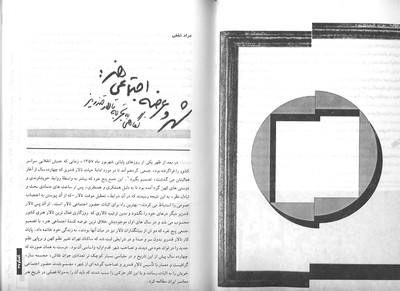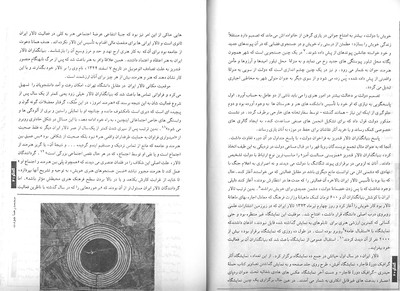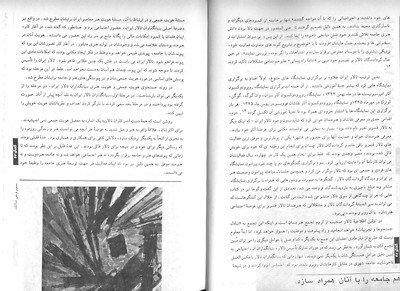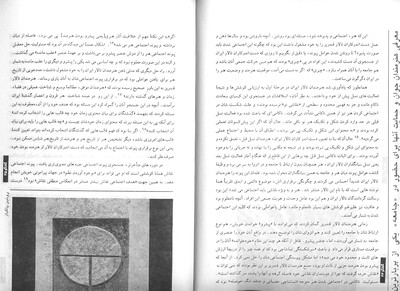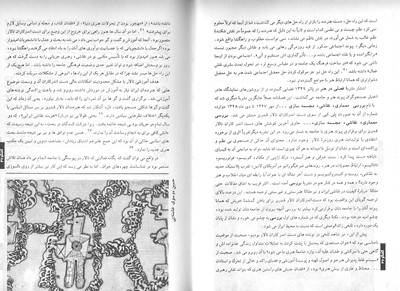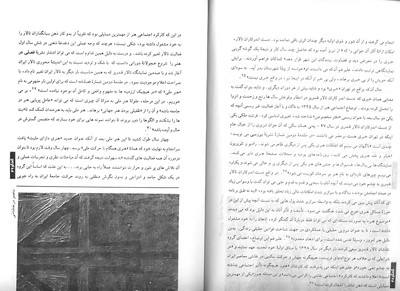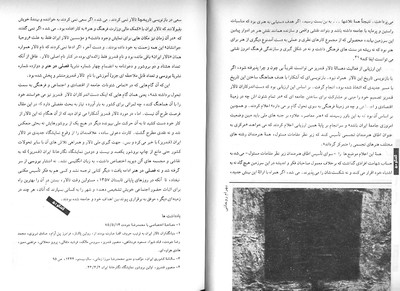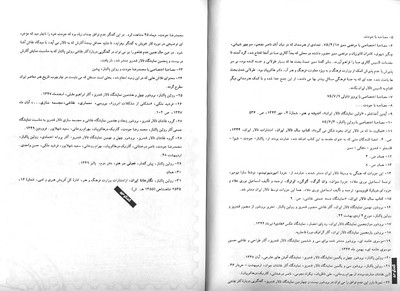Goftogou, Quarterly for Culture and Social issues, Nr. 13, Autumn 1996
Towards the end of September 1978, when the revolutionary movement had spread through Iran, a small group came together to decide the fate of Ghandriz Gallery, which had been active for the previous 14 years. After hours of discussion the five-member group concluded that under the circumstances, temporary suspension of the gallery would be the best way to prove its social presence – in an action that would be taken as support for the general strike. Since then, Ghandriz Gallery’s doors have never reopened and what was once regarded as the most active art space in the country, and the most creative space for the social presentation of art (particularly during its first few years) came to its end due to the decision of a five-member group (two of whom were its founders).
The closure of Ghandriz Gallery (which had also for some of its history been known as Iran gallery) had little impact on a situation in which Tehran’s citizens felt capable of changing the old order and establishing a new one – the first step of which was taking possession of the city. It had been similar 14 years before when, on a much smaller scale, a number of young painters, sculptors, graphic artists and architects decided to prove their social presence by taking possession of a tiny portion of the city and by establishing Ghandriz Gallery – this action caused a movement that must now be studied as a chapter in the history of contemporary art in Iran.
Ghandriz Gallery began in June of 1964. Under its first name, Iran Gallery, it held an exhibition of its founders’1 paintings. Most of the founders were born between 1936 and 1941, which meant they didn’t suffer from the lassitude caused by despotism, following the 1953 coup d’état, that had engulfed the preceding generation. Nor were they young enough to immediately benefit from the funds granted to the artists for public art in the late 1960s and early 1970s (through the arts funding organisation “The Special Office”). An earlier generation had greatly contributed to contemporary art by establishing the Apadana gallery in 1949. However, between 1949 and 1964 the cultural climate of Iran had undergone an essential change. In the first biennial of Iranian painters, in 1958, there were 40 participants, but in later years this number would increase significantly. The cause of this sudden increase was the foundation of The Faculty of Fine Arts in 1947, which, from 1951, began to present a remarkable number of artists to society. By the end of 1964, a total of 343 artists had graduated from this faculty. In the academic year of 1963-1964 alone (when Iran Gallery was established) the number of its graduates was 64. To this number must be added those who were engaged in painting or sculpture at art schools and the old-fashioned traditional classes.
In other cities and towns in Iran, there was almost no possibility for exhibiting art works and artists outside the capital were dependent on a few galleries in Tehran. The doors of these few galleries, however, were often closed to newcomers. The exhibition of works by a novice lacked the commercial potential to attract private galleries, and didn’t have a strong enough presence to attract the State-run galleries. What made this climate feel more restrictive for the founders of Iran Gallery was what they had come to recognize, after the establishment of the Faculty of Fine Arts and the Biennial, what possibilities and facilities their counterparts in other countries had.
The Iran Gallery artists’ perception of the situation was this: “The number of artists has increased excessively throughout the world. In Paris, London, New York, Rome, and Tehran, it is swiftly climbing towards the peak of its curve graph (...) But the possibility of establishing art organizations in most of the developed countries has been solved. Unfortunately, in Iran, there is still a lack of sufficient possibilities for artists to easily present their work.” (…) “To solve the financial problem that [seemingly] caused the main difficulty for working” the founders of the Iran Gallery decided to “join hands as friends, roll up their sleeves and pave the way to progress and success, working determinedly for a common cause.”2 They joined hands and established the Iran Gallery only to realize that, contrary to their view, the financial issue wasn’t the main problem, indeed, it proved to be the most insignificant. Although one could have become aware of other problems from the start, the difficulties of living and, for instance, the fact that the co-founder Mansour Ghandriz was compelled to work as a simple factory worker, had made the financial issue an undeniable priority for them. Work, social presence and experience were necessary to make all difficulties visible.
During this period, the possibilities for public presentation were so limited that the government decided to take action and sponsor art activities. Towards the end of 1963, the Office of Fine Arts invited artists to join discussions about how the grants should be distributed. The establishment of Iran Gallery and other centers, like Saba Gallery, were either in line with, or a reaction against, this invitation. The issue of being connected or not to the government was much discussed among groups of artists who were interested in establishing galleries.3 Generally, in that period, few groups were inclined to receive government grants, but the tendency to keep a distance from government was not necessarily motivated by politics. It neither intended to keep away from a system that had regained its lost power with the help of foreign forces, nor did it intend to avoid a government that had stood against a public uprising a few months earlier. The lack of interest in getting close to government must be sought in the will of a new generation of artists who did not find it necessary to rely on any factor other than the art itself. For them the new art they promoted could only survive with the support of art-lovers. Their unwillingness to harmonize their activities with the government can be compared to an adolescent refusing to receive help from his/her parents and trying to live an independent life. Confident of the correctness of his/her way, the adolescent is on a quest for a space where new relationships can replace predefined ones. In such a quest the city is seen as the only place for these new connections and is understood as the site for hopes and desires – a haven for the young artist. It is also in such a prospect that the government, as a given reality, on the one hand would be rejected, and on the other hand, as the administrator of the city, would become a compulsory audience.
The government’s decision to interfere in art affairs could be due to two factors. Firstly, to fulfill the need that it had been created through establishing the faculties and colleges of art, and secondly; to curtail the influence of exhibitions of Iranian artists hosted in foreign embassies or conferences (sometimes with a clear political agenda). The government, therefore, promised to help establish artists unions, award grants to establish private galleries, and support artists by buying their work and placing it in museums.
The response of the founders of Iran to the government’s proposals differed from the prevalent reaction. When, for example, the union of the writers reacted ‘sulkily’ to the government’s attempt to get close to it, the founders of Iran Gallery found a strategy of peaceful coexistence the most suitable. They neither found it necessary to establish a close association with the government, nor did they declare a war on it, which could have prevented the activity they wanted to initiate. Now, as they began their longed-for activity via establishing Iran Gallery, they saw no reason to make a new enemy by refusing the government’s offer. Thus on June 26th 1964, Iran Gallery opened its doors to an exhibition of the founders’ work, supported by a monthly grant of 6000 Rials, which covered the rent of the basement of a publishing house opposite the main entrance of Tehran University.
The exhibition was an unexpected success. Even those who did not value the kind of paintings on display admitted that the general public welcomed it. During the 10-day period of the exhibition more than 2000 people visited it, a reception that encouraged the founders of the gallery to continue their activities.
In the first year Iran Gallery held ten exhibitions. Among them were graphic works of Qajar period, posters, record sleeve designs, pictures of the book Hamle Heydari4 (also graphic art of Qajar period), and works of the photographer Hadi Shafaiya, entitled Footprints of Ages. All were undeniable innovations. Holding exhibitions like these also indicates that the financial aspect of the public presentation of art was of secondary importance to Iran Gallery. The aim was to invite society to value art and to become familiar with an extensive range of work. The founders of Iran Gallery were devoted to art. Following the untimely death, in a car crash, of Mansour Ghandriz (one of Iran Gallery’s co-founders) on February 28, 1966, the remaining founders renamed the gallery after him to show their respect for the art and the artist.
The location of Iran/ Ghandriz gallery, in front of Tehran University, meant that art students tended to visit, and the frequency of this contact caused the founders of the gallery to quickly realize that the “artists in this country are involved in various complicated predicaments that have been hidden for a long time and if they were to continue their way with genuine eagerness and free from implications and dependencies peculiar to their environment, they would face the problems in more severe forms”.5
Thus, towards the end of the first year of Iran Gallery’s life, not only wasn’t there “any hope for the support of the true advocates of art” but there was talk of “a very deep gap between the artist and society, preventing close contact between the two... This would result in the artist avoiding society and society negating the artist, which in any case it was a severe social defect”.6 The founders of the gallery saw the reason for this gap the lack of an intermediate element that “could act like a bridge between the artist and society so that the artist would not have to describe and justify his/her artistic explorations to lessen the oddity of his/her work or to be effective in elevation of the level of art in society.” However, Iran Gallery felt responsible enough not to impute “the confrontations they had with their observants, and the objections and problems they had faced during its first year” to shortcomings of others or the incompatibility of the art environment. Therefore they tried to promote the art knowledge of society and function as intermediary. They increased their publications, lectures, and debates “to describe and explain different aspects of their work to get closer to their opponents and to reconsider any probable mistakes”.7 They decided to go on despite all the problems.
Thereafter, in addition to various exhibitions, Iran Gallery held exhibitions with an educational dimension, such as the reproduction of impressionist works in February 1966, reproduction of works by Cezanne, Van Gogh, Gauguin, and Lautrec (October 1966) as well as reproductions of Fauvist paintings (February 1967). Booklets accompanied these exhibitions, completing their educational remit.8
Next to such exhibitions, Ghandriz Gallery made an earnest effort to exhibit the works of younger artists who couldn’t otherwise find a place to show. The introduction and support of young artists in the city was one of the most fruitful and successful activities during the life of Ghandriz Gallery and even if it were the only thing that they had done, their report card would still carry a positive assessment.
Other activities included; holding one-to-one or group panel discussions about the gallery’s exhibitions and public discussions about the conditions of art in Iran. These discussions were recorded in small brochures and sold to the visitors for a very low price. A number of the discussions were also printed in books occasionally published by the gallery. It is through those discussions that one might learn about the train of thought of the founders of the gallery and the problems artists experienced in the public presentation of their work.
In the gallery’s first announcement, the necessity to bring artists together is expressed, and this “exchange of findings and experiences,” is expected to pave the way to progress and success. But it is totally unclear what other factors they shared in common, other than a shared financial dependency. It seems that in the period when the gallery was established, the founders did not find it necessary to determine the common factors of their solidarity. It was only when the founders faced the feelings of isolation following negative reactions to their work that the issue of collective identity and, consequently, the identity of Iranian contemporary art became the center of their attention. Indeed the main concern of the founders was social presence, and as I mentioned earlier, they regarded the lack of financial resources as the only obstacle to achieving such a social visibility. Their identity was defined by their presence as artists and their existence was made manifest through art production. In the beginning, they supposed that their relation to society would be a natural one, and simply sought a place to realize its material possibility. Iran Gallery had to appear as a place with such a function. After establishing the gallery, however, they found that the relation they wished for would not be achieved so easily. It was only at this stage that they began to ask essential questions about their collective identity and the relation of art with society.
In the course of seeking the collective identity and the artistic identity, two stages can be distinguished. In the first stage, the founders of Iran Gallery began to criticize what came before, and in the second, they tried to define their identity by expressing their aims and opinions.
Certainly, all of the founders of the gallery were not equally concerned with the problem of collective identity. For most of them, intense interest in art and the desire to present whatever brought art and everyday life together were sufficient reasons for collaboration. There were a few who held different views about themselves and the gallery, who believed that before the relation between art and society could be established, art would not become public and therefore society would not learn to appreciate art, nor would the artist be successful. That was why they found it a task to bring society closer to art.
There was consensus on the fact that art had to become social (and accepted by society). But what was unclear, and had engaged the minds of the gallery’s founders, was how this socialization could be actualized. Until they could find the answer, or stop searching for one, they sought ‘something’ that would represent both their collective move and the tangible support from society itself. This ‘something’, if achieved, would totally change the position of the artist and the conditions of art in Iran.
In the first stage, Iran Gallery artists made an assessment of the efforts and achievements of the preceding generation. They believed that their predecessors, having a limited and superficial understanding of ‘modern painting,’ had failed to find that ‘something’, which is why they failed to socialize art – this failure prevented the past generation from advancing beyond ‘form and technique’. If, however, those veterans “had reflected upon the content of the form and technique, conformity of modern art to the environment and society had become possible”.9
According to the Iran Gallery artists, previous generations had not understood the meaning of form and technique, and had failed to established any movement in art. This failure was verified by their strong assertion that by the time the preceding generation began their work, art had not yet connected with society and was still isolated; and thus the responsibility of discovering the factors needed to bring art and society closer was passed onto the artists at Iran Gallery. These artists felt the lack of such a connection intensely, and how to establish such a connection was the perennial subject of articles published by the gallery. Art, and particularly painting, had to be socialized – this maxim defined their collective identity – but what remained unidentified was the factor that allowed for the socialization of art.
At some point, the artists of Ghandriz Gallery thought that they could simultaneously determine their connection with society and justify their isolation by calling themselves “avant-garde.” In fact, they regarded themselves as members of society – but progressives. They were unaware of the fact that although their self-ordained titles – as progressive artists – would put them in a prime position to become dismissive of visitors who saw “everything through their fixed and limited values,” it would not solve their lack of connection with society. Since progressiveness of the artist was part of his/her nature, the group of painters at Ghandriz Gallery believed that “one could not object to a painter for becoming distant from their fans and advocates and leaving them behind”. The responsibility of the failure for the socialization of art was put on the shoulders of “angry visitors and impatient critics” who, “if they realized the importance of creativity in art (that is the progressiveness of the artist) distance would be removed and a social relation would be established.”10 The main problem with this view was that it transferred the responsibility of solving the issue of social contact from the progressive subject to “the one who lagged behind.” Of course, in this case it would not be clear how to determine who was progressive and who was lagging. Another solution that the artists of Ghandriz Gallery were thinking about for a while was seeking help from the history of art to find factors that might help them to establish social contact. The artists arrived at the correct belief that “successful artists had vast knowledge of space, time, and the arts of the past”.11 Therefore they decided to study Iranian art of the past centuries. What mislead them in their search was that they concentrated on “the forms their predecessors had chosen to express the content of their time” to learn what the content of their own time was, and “what forms they had to choose to express it”.12 If understanding the forms adopted by the old masters of Iranian art could determine today’s forms, then it would not be possible to distinguish art from art history, or the artist from the art historian. That is, this kind of relation with society would end up in resignation of the artists of the gallery from being artists.
In later years, looking for social connection became a more spiritual undertaking. The painter’s social connection was the attempt to “establish order” in his or her environment. Therefore, “the painter’s social aim was for the most part a logical reflection”.13 It is true that this solution would leave the painter freer compared to other solutions, but since it did not determine what was order and what was disorder, and also because it would give the artist – who is usually regarded as the violator of the status quo – the role of one who establishes order, it could not be desirable and effective. At other times, that social connection would become free from everyday routine and the painter would be no longer obliged to be a “social instigator or critic... with direct and immediate influence”. To be social means “the artist should have an active role in the making of the culture of a society, and, in a larger scale, in the development of human civilization”.14
This solution represented nothing more than an extension of the problem of the socialization of art into a still more complex area, that is, the relation of art with larger societies.
Publication of the quarterly A Chapter in Art in autumn of 1970 provided a larger space than the gallery brochures for the seekers of a relationship between art and society. The quarterly was actually a substitute for a publication named Study of Architecture, Painting, and Sculpture, which Ghandriz Gallery had published in 12 stenciled issues between October 1968 and June 1969. Study of Architecture, Painting, and Sculpture was Ghandriz Gallery’s last effort in establishing a relationship with society. In the publication there was almost no critical view of the daily art productions of the gallery. It contained an irregular, sporadic search that indicates desperate resort to anything that might help to establish the connection that had been longed for: Oriental tradition and abstract art, Japanese perception of space, Cubism, Dadaism, spirituality in art, non-figurative trends in Latin America, approximation of the new plastic arts to painting, Russia and constructivism, and, finally, an article entitled Is there any relation between revolution and art? Most of these articles, even the articles on the quality of Iranian painting and traditional and non-traditional art were translations. The high quantity of translated articles indicate that to find their missing intermediary, which could establish their contact with society, the founders of Ghandriz Gallery had resorted to what had been produced outside of their society. The first issues of Study of Architecture, Painting, and Sculpture, which indicates the end of a period, on the other hand reflects an excessive bitterness towards their environment.
Even before that, one could witness a kind of bitterness in the articles written by the gallery’s founders. They talked about an unsuitable situation that a “talented youth, who had probably turned their back against common values of their family, or perhaps even revolted against them to enter the art world” would face. There was also talk of “the wrong system of admittance of students, an old and outdated educational system, stagnant and lethargic atmosphere, and cautious teachers with no artistic insight.” They also wrote about the “lack of true art movements with leading roles”, about being “isolated from artistic developments in the world,” and the “lack of books, magazines, and other means of improvement.”15 However, in those days, the founders of the gallery thought there was still a way to get out of such problems. Where education did not work, it was still possible to rely on discussion and debate with students. And if debate with the students who would angrily criticize their innovations did not work, they could still hope to establish a new style in painting and lead a movement that would gradually expand to cause a basic change in the cultural status of society. However, none of these solutions were actualized because each was faced with a mountain of difficulties.
The educational ambition of the gallery – limited by the financial resources of the founders and the expansion of the subjects that Iranian artists needed to be educated in – resulted in dispersed educational texts. Holding discussions in order to clarify these issues did not bring about the expected results either. When the discussions found a regulated form, it became evident that the founders of Ghandriz Gallery had basic disagreements on essential issues.16 Also a long discussion on “the identity of Iranian painting” that had taken two full years was left without any clear conclusion because the participants found that they had not enough knowledge to conclude it.17 The disagreements and suspension of the basic discussions indicated that the group, despite its great eagerness, did not have the capability to devise a new art movement.18
In fact, the only activity of the gallery that coincided with society was its continuous efforts to introduce young painters. But it seems that this was done out of sympathy; there was not much left of their primary enthusiasm. The founders of the gallery, for instance, provided the possibility of presenting the works by “some young artist who had come a long way from provincial Tabriz hoping that the product of years of effort would be seen and judged by his fellow-countrymen in the capital”. They arranged an exhibition for him though they knew that “he just wanted to get out of the isolation of his home town, coming to Tehran to see what was going on, not knowing that in fact there was nothing going on here either.”19
Whereas in fact there was something going on – and perhaps more than ever – perhaps, in a sense, what the founders of Ghandriz Gallery had tried to achieve in isolation was suddenly made possible through the agency of the state. The social circumstances of art had suddenly undergone an essential change in 1966 when a new organization – which was a few years later to be called the special office – began its unofficial activity. Farshid Maleki, an artist of Ghandriz Gallery wrote in 1968 – the same year he had told that young artist from Tabriz that there was nothing going on in Tehran – in the introduction of the second issue of Study of Architecture, Painting, and Sculpture that “recently I see art-related events occurring one after another. The radio and television have begun to broadcast news and critiques about art. Newspapers and magazines have allocated a page to art, annual and biennial exhibitions, festivals and art celebrations are held one after another, and we suddenly see that some new things are striking us on the head as art”.20 Indeed, the Ghandriz group was now witnessing that what they had intended to do step by step with a lot of hardship and excessive care was quickly being actualized through the injection of huge funds. Of course, the new activities were not in accordance with what they had planned but due to the money that seemed very huge in comparison with the amounts spent in the field of art before. Their pity was that they saw that “art has occupied the minds as what could only be talked about rather than a true force functioning towards the recognition of the real rules of life. Thus today’s art has become a leisure for a limited number of people.”21 Despite such a condition, in 1969, the Ghandriz painters renewed their primary vow and while declaring that “contrary to all fallacious claims, there is no progress and pure movement in Iranian contemporary painting,” and admitting that their work “has as yet no social effect”, they announced that they regarded “the social function of painting as a necessity”, something that still occupies their minds “as one of the most important issues”.22
There is no doubt that the social function of art was one of the most important issues that occupied the founders of the gallery, though the practical aspect of this concern had changed over the first six years of their activity. It is exactly because of this long-time concern that the publication of “A Chapter in Art” can be considered as a bashful beginning of a period in which they hesitantly began to discuss that pivotal thought and later declared it confidently at the one-hundredth exhibition of Ghandriz Gallery – an occasion when the gallery was again called Iran Gallery. In the introduction to the second issue of the quarterly we read for the first time the concept of “national art,” which “has not truly and thoroughly developed in any field of art”.23 In this period, the issue of national art was seen as “something that could be a factor of dynamism of art in society” and what could help it gain its independence from “the unwanted universal art”. The national art had to help artists “to break the idols and discard the archetypes to be able to create its own models that would insure development at present and in future.”24
It took four years for the term national art to change to “the art with a nationality” and finally reach the extremity of “the art in accord with the national movement.” It took four years to “easily decide that all those past activities, all those theoretical discussions and practical experiences and enthusiastic efforts could not actually yield any result... and this was because the group was seeking its goal in a stiff and abstract way and without a logical view of the course of Iranian society. Consequently all efforts... failed. If the aim was to achieve an art with true and rich relations with society – one that could have a real and constructive role as the role of art in this country in the past eras – the result of the whole theoretical and practical attempts was however a kind of art for art’s sake that neither had its roots in past cultural traditions nor could play a role in the formation and construction of today’s culture”.24
The above assessment of the ten-year activity of Ghandriz gallery could almost be accepted unquestionably if it was not accompanied by the rewriting of its history, a rewriting that was evidently attempted with the aim of bringing its history in line with the new course that was adopted. It was on the basis of this assessment that the founders of Ghandriz gallery declared their decision to participate in making a society that would advance towards development in all aspects, including economical, social, and cultural. It was also based on this assessment that they came to believe that “contemporary art must in addition to the national aspects, represent the condition of present Iranian society”. And, finally, it was based on this assessment that they declared that they wanted to establish a center as “the room for visual artists, to centralize all the artists of different branches of visual arts under the supervision of the related authorities.”
These positions – except for the establishment of the artists’ room under the supervision of the authorities – could have been put on the account of their courage for admitting – contrary to most intellectuals in this country – their mistakes and accepting their defeats, if only they did not try to rewrite the history of the gallery in line with their new standpoint, if they did not try to make their readers and visitors believe that Iran Gallery was established with “the help of The Ministry of Culture and Art,” if they did not say that “in those days there were other places for exhibiting art” and that the founders of the gallery had gone through so much trouble “only due to their young spirit”, and, finally, if they did not claim that the name of their Gallery had always remained Iran Gallery and “Ghandriz” was only an appendage to the main name, ignoring the fact that eighty-two brochures and invitations, plus four issues of A Chapter in Art and twelve issues of Study of Architecture, Painting, and Sculpture and a remarkable number of educational pamphlets had been published under the name of Ghandriz Gallery.
To answer what were the fruits of the steps taken “towards development in all aspects of society including economical, social, and cultural” that is, the steps the founders of Ghandriz Gallery now intended to bring themselves in line with, requires a detailed discussion that can not be included in this article. However, in the case of Ghandriz Gallery, it is quite evident that since it abandoned its own work to join that national movement, there were no longer any discussions or critiques in any of its brochures. Only simple invitation cards would inform the interested of a new exhibition at Iran (Ghandriz) gallery. Even the national position taken by the gallery and the accord of its efforts with other transformations in the country did not prevent it from the publication of the brochure for its one hundred and twenty second exhibition in English language, which was allocated to the paintings and sculptures of Alan David. They neither continued the publication of Study of Architecture, Painting, and Sculpture, nor A chapter in Art. No more books were translated, and, nobody thought of a new movement in art. Finally, in the last days of the summer of 1978, those in charge of the gallery found the closure of the place the best way of proving their social presence, giving up the city to those who had succeeded in establishing a relationship between their aims and society, though in a different field.
Footnotes:
1-The founders of Iran Gallery were Rouin Pakbaz, Faramarz Pilaram, Sadegh Tabrizi, Mohammad-Reza Jodat, Ghobad Shiva, Masoud Arabshahi, Mansour Ghandriz, Sirus Malek, Farshid Mesghali, Parviz Mahallati, Morteza Momayez, and Hadi Hezareiy.
2- Mansour Gandriz, First Iran Gallery exhibition brochure, 25/6/1964
3- Interview with Morteza Momayez, 9/7/1996. A group of artists, including Naser Mofkhem, Manouchehr Shibaei, Changiz Shahvagh, Kamran Katouzian and Morteza Momayez, had gathered in a place – where Saba Gallery was later allocated – to discuss the preliminary steps for establishing the Saba Gallery. According to Morteza Momayez, the great part of the discussions that were long and tiring, were about accepting or refusing help from the Ministry of Culture and especially from the secretary of its art and culture department Dr. Hakoupian. The endlessness of the discussions resulted in a group of artists who placed more emphasis on the cultural aspects of the issues to depart and with the help of some other artists start the establishing of Iran Gallery.
4- A Persian book of religious epic poems about Imam Ali (first Imam of Shiite Muslims) written in 18th century.
5- Our activities taking shape in Iran Gallery, Annual book of Iran Gallery, Iran Gallery Publishers, 1965, P. 3. The article that was included in the annual book as an introduction was signed by: Pakbaz, Jodat, Shiva, Ghasemlou, Ghandriz, Mesghali and Momayez.
6- Ibid., P. 4.
7- Ibid., P. 8.
8- These Booklets were: Impressionism, by Serra Newmar, translated by Ismael Nouri-Alaa, Cézanne-van Gogh-Gauguin-Lautrec, translated and written by Ismael Nouri-Alaa, About Fauvism, translated and written by Ismael Nouri-Alaa.
9- Annual book of Iran Gallery, Group Painting Exhibition, P. 9.
10- Brochure for the ninth Iran Gallery Exhibition, With works by Mansour Ghandriz and Rouin Pakbaz. Written By Ghandriz and Pakbaz. 24/2/1965.
11- Brochure for the twelfth Iran Gallery Exhibition, Trace of the Ages, Hadi photography exhibition, July 1965.
12- Brochure for the eleventh Iran Gallery Exhibition, Graphic works from the Qajar period.
13- Mousavi Khamenei, Brochure for the thirty-sixth Gandriz Gallery Exhibition, Drawings and paintings by Hossein Mousavi Khamenei, February 1968.
14- Rouin Pakbaz, Brochure for the forty-first Gandriz Gallery Exhibition, Exhibition for foreign posters, Novebmer 1968.
15- Rouin Pakbaz, Brochure for the thirty-first Gandriz Gallery Exhibition, Exhibition of Young Painters, May – June 1967.
16- A clear example of this kind of disagreements can be read in a discussion about Mohammad-Raza Jodat’s paintings published in the brochure for the twenty-forth exhibition at the Gandriz Gallery. The disagreements were quite deep that Mohammad-Raza Jodat had to ad an appendix to the booklet explaining his work, so that the at least the those who would visit the gallery to view his work, would get acquainted with his point of views. Such disagreements can also be retraced in another discussion about Rouin Pakbaz’ paintings, which was published on the occasion of the presentation of his work during the twenty-fifth Gandriz Gallery Exhibition.
17- Private interview with Mohammad-Reza Jodat and Rouin Pakbaz, 1996.
18- The content of the attempts to conceive a new art movement is a discussion that needs to be addressed in the frame of the history of Iranian contemporary art.
19- Rouin Pakbaz, Brochure for the forty-eighth Gandriz Gallery Exhibition, with work by Ibrahim Moghbeli, February 1969.
20- Farshi Maleki, A problems of today’s problems, Study of Architecture, Painting, and Sculpture publication, October 1968, P. 1-2.
21- Brochure for the fifty-seventh Gandriz Gallery Exhibition, Gandriz Gallery Painters’ Group, with works by Rouin Pakbaz, Mohammad-Reza Jodat, Garnik Derhakoupian, Bahram Rohani, Saeid Shahlapour, March 1970.
22- Brochure for the forty-ninth Gandriz Gallery Exhibition, Gandriz Gallery Painters’ Group, With works by Parvaneh Etemadi, Rouin Pakbaz, Mohammad-Raza Jidat, Naser Derakhshani, Garnik Derhakoupian, Bahram Rohani, Saeid Shahlapour, Farshid Maleki, Hasan Vahedi, April 1969.
23- Rouin Pakbaz, introduction to the second issue of the quarterly A Chapter in Art, autumn 1970.
24- Ibid..
25- Rouin Pakbaz, Negarkhane-e Iran, issue 16, Ministry of Art and Culture publishers, Office of arts and literature creation, 1976.
